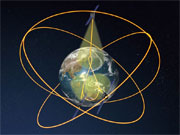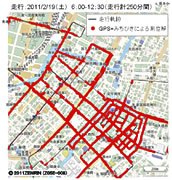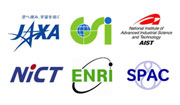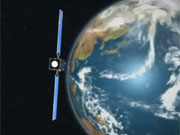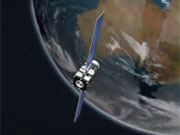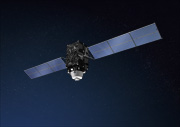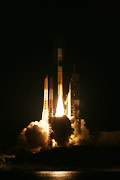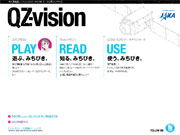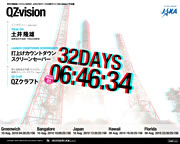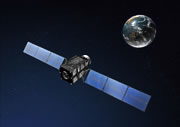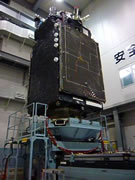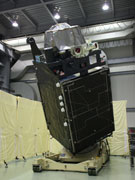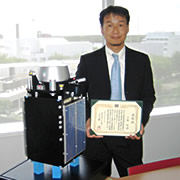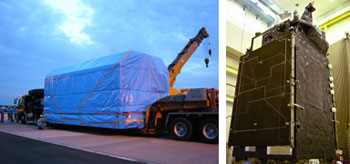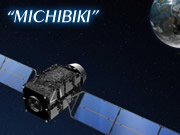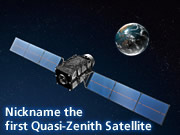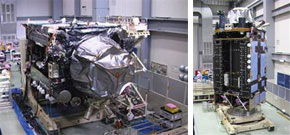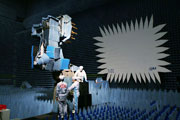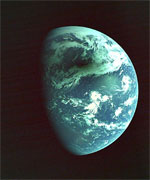Feb. 22, 2017 Updated
QZS-1 off to the Cabinet Office's Control
On February 28, 2017, JAXA discontinues the operation of QZS-1, the First Quasi-Zenith Satellite MICHIBIKI. Control will be transferred to the Cabinet Office.
For details, please refer to:
|
|
Nov. 28, 2013 Updated
Satoshi Kogure Awarded with Leadership Award in GPS World 2013
Satoshi Kogure, mission manager of the Satellite System Technology Unit, was awarded with GPS World 2013 Leadership Award (Satellite Division), hosted by GPS World.
The award is given annually to the most distinguished figure in the Departments of Satellite, Signals, Services, and Product. The voting process was taken by GPS editors and 40 experts.
Kogure took part in the initiation of Multi-gnss Advanced Demonstration tool for Orbit -and-Clock Analysis (MADOCA) since 2001, in the development of the first Quasi-Zenith Satellite MICHIBIKI, which was launched in 2010. He has also led the technological development of GNSS such as GPS and Galileo in cooperation with other pertinent countries, and has promoted the application of the satellite technologies.
The ceremony was held on September 19, 2014 at Hermitage Hotel, Nashville, TN, USA.
|
|
Dec. 20, 2012 Updated
MICHIBIKI: Current status of rubidium atomic clock 2
The First Quasi-Zenith Satellite “MICHIBIKI” is equipped with two rubidium atomic clocks, Clock 1 for the operation system and Clock 2 for the spare system, to construct the redundant structure. The former is currently used for generating positioning signals.
At 2:40 a.m. on Dec. 19 (Japan Standard Time), we found an anomaly in Clock 2, and we have not been able to restore its normal operations. We keep generating and providing positioning signals normally using Clock 1 while investigating the anomaly cause and studying countermeasures.
|
|
Jun. 4, 2012 Updated
MICHIBIKI: Suspension and resumption of positioning signal provision
At 1:42 a.m. on June 4 (Japan Standard Time), the time generation system of the MICHIBIKI, including the rubidium atomic clock 2, became unstable, thus positioning signals were not generated normally. As a result, JAXA temporarily stopped providing the signals. We then switched to the redundant system, the rubidium atomic clock 1, and confirmed that operations are smoothly working as well as that no impact was observed on MICHIBIKI’s signal precision. Therefore, we resumed the positioning signal provision at 10:15 a.m. on the same day. The service is progressing without any problem. We will continue engineering verification while investigating the cause of the glitch.
|
|
May 21, 2012 Updated
MICHIBIKI took images of Earth at the time of the annular solar eclipse!
At around 7:34 a.m. on May 21 (Mon.), an annular solar eclipse was observed from many places in Japan including metropolitan areas. At that time, the Quasi-Zenith Satellite-1 “MICHIBIKI” shot images of the Earth from space. You can see that the area above Japan was blackened because it was shaded by the moon due to the eclipse. In addition to the MICHIBIKI, the Solar Physics Satellite “HINODE” also captured some images of the solar eclipse.
|
|
Sep. 22, 2011 Updated
Call for Applications: JAXA's Multi-GNSS Joint Experiment 2011
JAXA is pleased to announce the start of the CALL FOR APPLICATIONS: JAXA's Multi-GNSS Joint Experiment 2011 from September 22, 2011. JAXA's Multi-GNSS Joint Experiment 2011 is a demonstration project by using Multi-GNSS including QZSS, which approved by Multi-GNSS Asia (MGA) as MGA recommended project. JAXA will provide multi-GNSS receivers and antennas for the demonstration project. The main objective of Multi-GNSS Joint Experiment 2011 is to promote the utilization of Multi-GNSS including QZSS in Asia Oceania Region by demonstrating quantitative effects of Multi-GNSS and exploring new GNSS Applications of more available and accurate satellite positioning service. The deadline for applications is October 14, 2011. The proposed joint experiments will be discussed in the 3rd Asia Oceania Regional Workshop on GNSS For further information about the project and the application process, please visit the following website:
|
|
Jul. 14, 2011 Updated
MICHIBIKI provides all GPS supplementary signals
The alert flags for positioning signals of L5 and L1C for the first quasi-zenith satellite (QZS) “MICHIBIKI” were removed on July 14 as we have confirmed that their quality and reliability satisfy the QZS system user interface specifications.
Along with the L1-C/A and L2C signals, whose alert flags were lifted on June 22, all alert flags for the GPS supplementary signals have now been retracted.
L5 and L1C signals are called “modernized GPS signals” because they are expected to be further improved in ranging accuracy and have less multi-path errors compared to L1-C/A and L2C signals.
|
|
Jun. 22, 2011 Updated
MICHIBIKI begins providing positioning signals
As the quality and reliability for part of positioning signals (L1-C/A and L2C) of the First Quasi-Zenith Satellite (QZS) "MICHIBIKI" were confirmed to satisfy the QZS system user interface specifications (IS-QZSS,) the alert flags for these positioning signals were lifted.
Accordingly, a GPS receiver corresponding to the MICHIBIKI will be able to use MICHIBIKI's positioning signals for its calculations. Also, JAXA is engaging in promotional activities to develop a GPS receiver that corresponds to the MICHIBIKI, thus we expect to expand the environment where people can try and enjoy MICHIBIKI's effectiveness.
|
|
May 16, 2011 Updated
MICHIBIKI verified positioning rate improvement in urban areas through its signals
The first Quasi-zenith Satellite “MICHIBIKI” has been conducting full-scale technical and application verifications since last December. JAXA and Mitsubishi Electric carried our positioning experiments using the positioning signal from MICHIBIKI in some urban areas where views from positioning signals are hampered. The MICHIBIKI has an advantage to be located in almost the zenith direction of such areas. Through the experiment, we confirmed that the positioning rate was greatly improved by adding the MICHIBIKI to usual GPS-only positioning in the areas including Shinjuku, where is covered by skyscrapers, and Ginza, which is like a maze full of back alleys.
As a positive effect of this improved positioning rate, we have also verified that we can identify which lane a car is running on a road around Shinjuku metropolitan area through the navigation system using a low-cost gyroscope (a sensor to detect the rotation of a moving object), and also confirmed that we can expand areas and time for surveys using the GPS, which requires high accuracy.
JAXA continues technological verification for positioning signal accuracy and reliability improvement. Mitsubishi Electric keeps engaging in application verification aiming at MICHIBIKI’s practical use in car navigation, LBS (Location Based Services) and other fields.
Drawing: The Ginza district where positioning by the GPS + MICHIBIKI is possible
|
|
Dec. 15, 2010 Updated
MICHIBIKI starts technical and application verifications
The first quasi-zenith satellite "MICHIBIK" has been under the initial functional verification for about three months and, all the satellite bus and onboard mission devices were confirmed as functioning.
As a result, JAXA moved the operation of MICHIBIKI to regular mode on December 13 (Japan Standard Time,) and, accordingly, we will begin technical and application verifications of the MICHIBIKI with all organizations concerned.
Each organization already started partial technical verifications when the health of their onboard device(s) and ground systems was confirmed.
However, as JAXA switched all positioning signals to the standard code at 11:48 a.m. on December 15 (JST,) full-scale technical and application verifications will be performed by all the organizations.
|
|
Oct. 26, 2010 Updated
MICHIBIKI begins transmitting all positioning signals, ground stations confirm them
Following the transmission of the L1-SAIF signal from the L1-SAIF antenna aboard the Quasi-zenith Satellite “MICHIBIKI” on October 19, the other positioning signals (L1-C/A, L2C, L5, L1C, and LEX) were also transmitted from the MICHIBIKI’s L-band Helical antenna. While we were confirming that there was no interference with conventional satellite positioning services including the GPS service, we gradually increased the output power of the signals.
On October 26, we started transmitting the signals with their nominal full power, and confirmed that the ground system properly received them.
We will continue conducting the initial functional verification of the onboard devices (for abut three months after launch) in cooperation with organizations that are in charge of technical verification.
(Image: Earth image taken by MICHIBIKI onboard monitor camera at noon on Oct. 26 (JST)
|
|
Oct. 19, 2010 Updated
MICHIBIKI begins to transmit L1-SAIF signal
JAXA has been conducting the initial functional verification of the First Quasi-zenith Satellite “MICHIBIKI,” including its attitude control and communications systems, and satellite bus. The MICHIBIKI was launched on September 11 (JST) from the Tanegashima Space Center. On October 19, we started transmission of one of the positioning signals, namely the L1-SAIF signal (*1) from the L1-SAIF antenna (*2) of the MICHIBIKI.
We will make sure that the L1-SAIF signal does not interfere with conventional satellite positioning services such as the GPS service, then begin checking interference of other positioning signals transmitted from the MICHIBIKI in the same manner.
We will continue performing the initial functional verification of the onboard devices (for abut three months after launch) in cooperation with organizations that are in charge of technical verification.
*1: L1-SAIF signal: a GPS augmentation signal with information on positioning correction and GPS healthiness.
*2: L1-SAIF antenna: an antenna to transmit the L1-SAIF signal to the ground.
|
|
Oct. 12, 2010 Updated
Application Support System for Commercial GPS Receivers for QZSS
JAXA is beginning a system to support the application of commercial GPS receivers to the Quasi-Zenith Satellite System prior to the start of positioning signal transmission from the First Quasi-zenith Satellite "MICHIBIKI." The MICHIBIKI was launched from the Tanegashima Space Center at 8:17 p.m. on September 11, 2010 (Japan Standard Time, all the following dates and time are JST.)
This system will provide technical support to receiver/chip manufacturers who are willing to update their commercial GPS receivers that are currently applicable to car navigation and mobile phones to receive and process positioning signals broadcasted from the quasi-zenith satellite system, or who are willing to newly develop a receiver with such a function.
|
|
Sep. 27, 2010 Updated
MICHIBIKI injected into the quasi-zenith orbit with its center longitude of about 135 degrees
The First Quasi-Zenith Satellite MICHIBIKI, which was launched by the H-IIA Launch Vehicle No. 18 on Sept. 11 (JST,) has been maneuvered to shift its orbit from the drift orbit to the quasi-zenith orbit starting on the 21st. The satellite is now confirmed to be inserted into the quasi-zenith orbit over Japan with its center longitude of about 135 degrees through the final orbit control performed at 6:28 a.m. on Sept. 27.
We will carry out initial functional verification of the satellite including the onboard devices for about three months in cooperation with organizations for technological verifications.
|
|
Sep. 19, 2010 Updated
MICHIBIKI shifted to the regular control mode
The first quasi-zenith satellite MICHIBIKI, which was launched by the H-IIA Launch Vehicle No. 18 on September 11, was injected into its drift orbit (or the orbit that is one step before getting into the quasi-zenith satellite) after five apogee engine firings. Accordingly, JAXA confirmed that the MICHIBIKI shifted to the regular control mode at 7:31 p.m. on the 19th (JST), thus the critical operation phase has been completed.
We will take about a week to shift the MICHIBIKI from the drift orbit to the quasi-zenith orbit, and carry out initial functional verification of the onboard devices in cooperation with organizations that perform technological verifications for about three months.
|
|
Sep. 11, 2010 Updated
MICHIBIKI successfully launched!!
The H-IIA Launch Vehicle No. 18 (H-IIA F18) with the first quasi-zenith satellite "MICHIBIKI" onboard was launched at 8:17 p.m. on September 11 (Japan Standard Time) from the Tanegashima Space Center. The H-IIA F18 flew smoothly, and, at 28 minutes and 27 seconds after liftoff, the MICHIBIKI was separated from the H-IIA.
We will update you with the latest information on the MICHIBIKI on the special site.
(Photo: JAXA/Mitsubishi Heavy Industries)
|
|
Aug. 23, 2010 Updated
MICHIBIKI data publication site 'QZ-Vision' starts full-scale operations
The "QZ-Vision" website for the first quasi-zenith satellite "MICHIBIKI" is now fully open. The site, whose major purpose is to publish data acquired by the MICHIBIKI, consists of three themes, PLAY (to play with MICHIBIKI,) READ (to learn about MICHIBIKI) and USE (to use MICHIBIKI.) The site is designed to be enjoyable both for satellite positioning specialists and novices as it provides not only MICHIBIKI's operation information but also detailed explanation of the quasi-zenith satellite system, the 3D MICHIBIKI which you can touch and play with, and interviews with leaders in various fields, because "MICHIBIKI" means "to lead" in Japanese.
|
|
Aug. 10, 2010 Updated
Preview of 'QZ-Vision,' MICHIBIKI data publication site
The website "QZ-Vision" for publishing data acquired by the First Quasi-Zenith Satellite "MICHIBIKI" will open on August 23.
The site will not only provide operation information about the MICHIBIKI after its launch, but also offer detailed explanations about the quasi-zenith satellite system (QZSS) and the 3D MICHIBIKI with which you can touch and play, It will also publish interviews with leading experts in various fields including the famous cartoonist Cyuya Koyama. Both those who have never heard of the QZSS and specialists in the field can enjoy the site.
We are offering a preview of the site prior to its official opening. It currently is publishing an interview with Astronaut Takao Doi, Chief of the Space Application Section, United Nations, Office for Outer Space Affairs, as well as a launch countdown screen saver, and a 1/50th scale super precise paper craft "MICHIBIKI" on the site. Please enjoy them.
|
|
Aug. 4, 2010 Updated
MICHIBIKI new launch date decided!
The new launch date of the First Quasi-Zenith Satellite "MICHIBIKI" by the H-IIA Launch Vehicle No. 18 has been set for September 11 (Sat.) The launch time will be between 8:17 and 9:16 p.m.
The launch of the MICHIBIKI was postponed due to a potential concern in the onboard reaction wheels, but the said part was replaced, thus we are ready for the launch.
We welcome your support messages to the MICHIBIKI at its special site. The project team who develops and operates the MICHIBIKI is looking forward to hearing from you.
|
|
Jun. 23, 2010 Updated
MICHIBIKI launch delay
JAXA has been preparing for the launch of the H-IIA Launch Vehicle No.18 with the first Quasi-Zenith Satellite "MICHIBIKI" onboard on August 2, but a potential concern was found in the onboard reaction wheels of the MICHIBIKI. We need time to exchange the parts thus we have to postpone the launch.
We will announce the new launch day as soon as it is determined.
|
|
Jun. 9, 2010 Updated
Launch day of MICHIBIKI decided! Special site opens
The launch day of the H-IIA Launch Vehicle No. 18 with the first Quasi-Zenith Satellite "MICHIBIKI" onboard was set between 10:54 p.m. and 11:54 p.m. on August 2 (Mon., Japan Standard Time.)
We have opened the "MICHIBIKI special site" to provide updated information about MICHIBIKI's preparation and launch status. Please enjoy the site.
We are welcoming your support messages at the special site. We are looking forward to delivering your messages to the MICHIBIKI project team who are in charge of development and operation of the satellite.
|
|
May 31, 2010 Updated
QZSS receives award at 42nd meeting of the World Telecommunication and Information Society Day in Japan
Satoshi Kogure, Associate Senior Engineer of the Quasi-Zenith Satellite System (QZSS) Project Team, received an award for promoting international activities at the 42nd meeting of the World Telecommunication and Information Society Day in Japan sponsored by the ITU (International Telecommunication Union) Association of Japan.
The award recognizes that the project has played a central role in compiling recommendations and reports concerning characteristics of receiving and transmitting the QZSS and the protection standards during research and development of the QZSS. The achievements of the project have greatly contributed to international development of Japanese satellite positioning technology.
|
|
May 11, 2010 Updated
MICHIBIKI arrived at TNSC
On May 8, a ship transporting the Quasi-Zenith Satellite-1 “MICHIBIKI” arrived at a port on Tanegashima, Kagoshima Prefecture. The satellite was then loaded onto a large-scale trailer to travel to the Tanegashima Space Center (TNSC.) It was delivered to the Spacecraft Test and Assembly Building 2 (STA2) at the TNSC.
The MICHIBIKI will go through preparation operations for launch in the summer such as tests for inspection and propellant loading.
|
|
Apr. 26, 2010 Updated
MICHIBIKI open to the press
On April 23, the Quasi-Zenith Satellite-1, "MICHIBIKI", was open to the press at the Kamakura Works of Mitsubishi Electric Corporation. MICHIBIKI will be transported to the Tanegashima Space Center in May, and will undergo final launch site preparations to be ready for launch this fiscal year.
|
|
Mar. 29, 2010 Updated
Antenna interference/radio frequency presence tests
Between March 10 and 16, antenna interference/radio frequency presence tests were held for the Quasi-Zenith Satellite-1, MICHIBIKI, which provides a high precision positioning service.
For this test, radio frequency is emitted from the MICHIBIKI's onboard antenna in an anechoic chamber to confirm if the antenna is appropriately connected to the satellite and if its output does not interfere with other onboard instruments and antennas. Through this test, MICHIBIKI’s antennas proved to be fine.
All system tests for the MICHIBIKI are scheduled to be completed by mid April, and the satellite will be transported to the Tanegashima Space Center for launch in JFY 2010.
|
|
Mar. 4, 2010 Updated
The 3rd Call for Surprising Ideas for Positioning Application Services
Japanese first positioning satellite, the Quasi-Zenith Satellite-1 will be launched in 2010. Because the Quasi-Zenith Satellite uses unique orbit to stay close to the zenith of Japan, during certain time of the day, it will improve positioning accuracy of GPS as well as availability. lnnovative ideas for making full use of the unique characteristics of this positional information will be welcomed. Please visit the Satellite Positioning Research and Application Center (SPAC) website (URL listed below) for details, and to apply. Outstanding ideas received will be introduced to related business industry, institutions and other entities towards realization.
Submission period: June 30, 2010
|
|
Jan. 20, 2010 Updated
"MICHIBIKI" chosen as nickname for QZS-1
Some 11,111 people sent us various suggestions for the nickname campaign of the first Quasi-Zenith Satellite (QZS-1) scheduled to be launched in Japan Fiscal Year 2010, and among them, "MICHIBIKI" was selected.
"MICHIBIKI"means "guiding" or "showing the way."
Many people who proposed "MICHIBIKI" explained their selection reason as the QZS-1 is to show us a correct location using its accurate positioning information, and to guide us toward a futuristic society by establishing the next generation satellite positioning technology in Japan. As the name precisely illustrates the QZS mission, this name was chosen.
We held a draw to select one person among all the godparents who recommended "MICHIBIKI" to invite him to the Tanegasima Space Center, and Mr. Hajimu Nishikawa (in his 50s, from Wakayama Prefecture) won the invitation.
|
|
Jan. 15, 2010 Updated
QZS-1 Vibration Test succesfully completed
We were very pleased that many of you participated in our nickname campaign. Thank you very much. Please look forward to our decision on the name in late January.
The manufacturing of the first Quasi-Zenith Satellite (QZS-1) was completed, and various tests on it have been carried out smoothly. In December, a “vibration test” was conducted at the Kamakura Works of Mitsubishi Electric Corporation. The vibration test checks if the satellite is strong enough to withstand vibrations at the time of rocket launch. The satellite was placed on a vibration stand to be shaken back and forth, left to right, and up and down. We confirmed that no problem was found in the test.
Photo-1 is the QZS-1 on the test stand. You can see solar array paddles stowed on the left and right sides. A vibration simulator is behind the satellite to swing the satellite back and forth. After the X-axis direction vibration test, the QZS-1 was turned around 90 degrees to perform the Y-axis direction vibration test. Photo-2 shows the satellite positioned for the test in the Z-axis direction.
After the vibration test, the QZS-1 is scheduled to undergo an acoustic test to be ready for the rocket launch noise, a pyro-chock test to withstand separation from a launch vehicle, and a shock simulation for solar array paddle deployment.
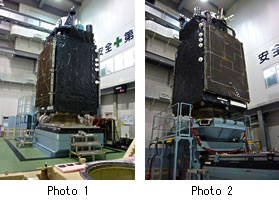
|
Dec. 4, 2009 Updated
Quasi-Zenith Satellite: Completed the thermal vacuum test
On October 30, the Quasi-Zenith Satellite project team completed the thermal vacuum test on the satellite which began on Oct. 1 as scheduled.
The test checked the satellite functions by placing it in a harsher temperature environment than space.The solar array paddles were attached again after the test (Photo left.) After the thermal vacuum test, an alignment measurement was preformed to check whether the positions and angles of the onboard sensors and thrusters were changed due to the test. We confirmed that the positions and angles were the same as they were before the test (Photo right.)
We are now preparing for the mechanical environment test (vibration test, acoustic test, and pyro-shock test,) which will begin in early December to inspect the durability of the satellite during its launch by a launch vehicle.
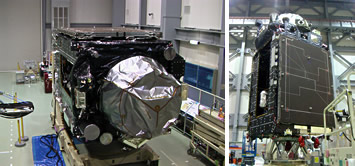
Photo left: QZS-1 with the solar array paddles attached.(The paddles are stowed on the upper and lower sides of the satellite.)
Photo right: QZS-1 during the alignment measurement.(The stowed paddle is on the front side in this photo.) .
JAXA is now asking the public to name the first Quasi-Zenith Satellite (QZS-1.) We will present a small gift and a certificate to all “godparents” (if a multiple number of people give us the same name that is chosen as the QZS-1 nickname.) Among the godparents, we will hold a lottery to select a person and his/her partner to the Tanegashima Space Center to see off the launch of the QZS-1 to space. We will accept entries up to 5:00 p.m. on December 16 (Tue, Japan Standard Time.) Please give the satellite an appropriate nickname
|
|
|
Oct. 19, 2009 Updated
QZS-1 Thermal Vacuum Test
The Quasi-Zenith Satellite-1 (QZS-1) is currently undergoing a thermal vacuum test that started on Oct. 1 and is scheduled to be completed at the end of October. The test continues 24 hours a day, seven days a week. A thermal vacuum test is to verify the thermal control and electric performance by placing the satellite into a test facility called a "Space Chamber," which simulates the space environment of high vacuum and cryogenic temperatures. Unlike on Earth, there is no atmosphere in space, thus the temperature on the satellite surface directly revealed to sunshine can reach over 100 degrees Celsius. On the other hand, the opposite side without sunlight becomes colder than minus 100 degrees Celsius. The test cheeks if the satellite can control its inside temperature and if the electronic devices work properly in such a harsh environment. Prior to the thermal vacuum test, an alignment measurement was conducted for the satellite to precisely measure the positions of its sensors and thrusters.
The alignment measurement will be held again after the test to make sure that the positions will not change. Currently we are asking people to give a nickname to the QZS-1. We will invite the godparent (if a multiple number of people give us the same name that is chosen as the QZS-1 nickname, we will hold a lottery to select a winner) to the Tanegasima Space Center to see off the launch of the QZS-1 to space.We will accept entries up to 5:00 p.m. on December 16, 2009. Please give the satellite an appropriate nickname.
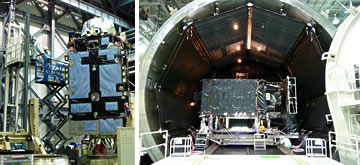
Left photo: QZS-1 during the alignment measurement (vertically positioned)
Right photo: QZS-1 taken into the Space Chamber to be ready for the test (horizontally positioned)
|
|
Oct. 16, 2009 Updated
Nickname the first Quasi-Zenith Satellite
- a signpost in space to guide you -
The Quasi-Zenith Satellite (QZS) is a positioning satellite to provide highly accurate GPS functions for car navigation and movable phone services in areas congested with skyscrapers and mountainous regions in Japan. The first QZS (QZS-1) is scheduled to be launched in Japan Fiscal Year 2010. JAXA would like you to give a nickname to the QZS-1.
We will invite the godparent (if a multiple number of people give us the same name that is chosen as the QZS-1 nickname, we will hold a lottery to select one) to the Tanegasima Space Center to see off the departure of the QZS-1 to space.
We will accept a nickname by 5:00 p.m. on December 16, 2009.
|
|
Sep. 14, 2009 Updated
QZZS proto-flight test starts
On August 17, the proto-flight test of the Quasi-Zenith Satellites System (System PFT) started at the Kamakura Works of Mitsubishi Electric Corporation.
Once a satellite is launched, it cannot be repaired. Therefore, meticulous ground tests are essential. The System PFT is a series of tests to confirm if an assembled satellite can function properly after going through the harsh environment of rocket launch such as powerful vibrations and being exposed to the stringent space environment of high vacuum and cryogenic conditions.
Following the first "visual inspection," the "electric performance test" was conducted between Aug. 20 and Sep. 3 to confirm that the QZ satellite worked according to its design. We will further perform various tests such as the "thermal vacuum test," "vibration test," "acoustic test," and "pyro-shock test" to verify that no degradation or abnormality shall be found in the performance that was confirmed by the electric performance test, and that the satellite is robust enough for space flight.
(Photo: The satellite system under the initial electronic performance test)
|
|
Aug. 31, 2009 Updated
JAXA and NOAA open ground monitor station for QZSS
On Aug. 25, JAXA and the National Oceanic and Atmospheric Administration (NOAA) of the U.S. unveiled a ground station in Guam for tracking and monitoring signals from the Quasi-Zenith Satellite System (QZSS) based on cooperative relations between JAXA and NOAA. The first mission of the QZSS is scheduled to be launched by JAXA in the next Japanese Fiscal Year.
JAXA and NOAA have been coordinating to establish a QZSS monitor station at the Guam Weather Forecast Station. The agreement reached by JAXA and NOAA allows for JAXA to install its antenna and equipment such as a receiver in the NOAA facility and also for NOAA to share QZSS observation data received at this new Guam station.
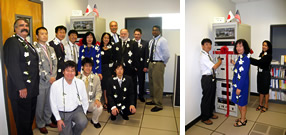
(Left: Members of the NOAA Guam Weather Forecast Office and JAXA QZSS Project.
Right: The receiving station for positioning signal observations installed at Guam)
|
|
Oct. 10, 2008 Updated
L-antenna Sinusoidal Vibration Test
On October 6, the L-band antenna sinusoidal vibration test was completed at the Structural Test Building at the Tsukuba Space Center.
A vibration test is an important gateway to a successful launch as it verifies if onboard equipment is performing normally after a satellite goes through the enormous vibrations of launch. A satellite cannot be launched without surviving this test.
The test was successfully completed and no problem was found in the L-ban antenna.
The L-band antenna is an “L-band helical array antenna.” It is an antenna using a L-band composed of an array of antenna elements that are helically coiled.
The antenna of the Quasi-Zenith Satellite System is formed with 19 coils of helical antenna elements, thus it has a high gain. Moreover, it is a very superior antenna as it can transmit signals at the same level to users who are at various locations where the distances from the satellite are different due to the spherical surface of the earth.
|
|
Apr. 16, 2008 Updated
Proto Flight Test on the Antenna of the Quasi-Zenith Satellite was performed
On March 7, 2008, the Proto Flight Test on the antenna of the Quasi-Zenith Satellite was performed in the No. 1 radio wave test facility at the Tsukuba Space Center. The radio wave patterns of the on-board antenna were measured and the "Compact Range Systems" were set up to distribute the radio waves to the transmission feed, the reflector and the Quasi-Zenith L-band antenna, respectively, and confirmed if the antenna met quality requirements.
|
|
Jan. 22, 2007 Updated
Interface Specifications for the Quasi Zenith Satellite System (QZSS)
JAXA publicly releases the initial version of the "Interface Specifications for the Quasi Zenith Satellite System (QZSS)"(IS-QZSS Version 0.0.) This document summarizes the specifications of positioning signals and messages sent from the QZSS, its service outline, and performance.
|
|




